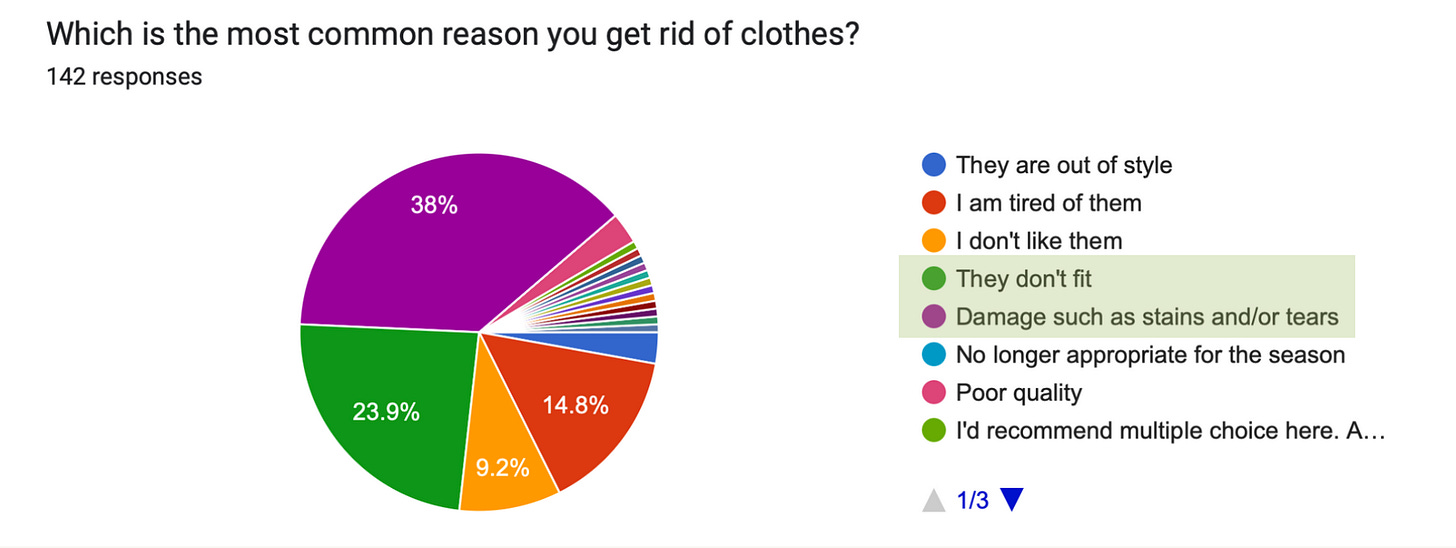Cloth Conscious: Understanding Consumer Textile Behaviors
Exploring the gap between consumer textile practices and sustainable business opportunities
Readers, as you might have already known, I’m quite curious about manifesting textile circularity :) There are an increasing number of industry reports that reflect the progress towards a circular economy in textile and apparel production. However, on a smaller scale, I’m also curious - do people care about the textiles of their lives? Do they try to extend the lifespan of their clothes and textiles, and what are the challenges they face to do that?
So that’s what I set out to investigate. Last fall, I joined Cohort 6 of Climatebase Fellowship. I gathered a team of like-minded individuals to create a comprehensive survey to assess people’s relationship with clothes, and the challenges they face in extending the lifespan of their textiles. At the end of the cohort, we managed to get more than 150 completed responses for the survey that takes about 10 minutes to complete. Let’s take a look at the survey insights!

As a textile upcycling artist, I want to be realistic about the demand of upcycling / garment repairing work in my local community (San Francisco Bay Area). More than ever, sustainable practices are pushed to develop a sound business case, instead of relying on the “trendy” awareness of sustainable approaches.
With that in mind, sorting and analyzing the survey has been a great learning experience! I’d like to share some key findings from the Circulate Your Textiles project in this issue. I hope it can shed a glimpse of light to the sustainability prospect of upcycling / garment mending businesses in the Bay Area.
First, I’d like to be clear about several biases observed in the survey responses.
The isolated sample size (155 responses) are from continental US states, 52% of them come from the Bay Area
80%+ of respondents are women
56%+ of respondents are between the ages of 25 and 44
Household income is $120k and higher
~33% of respondents only purchase clothes for lifestyle demands,
25% of them avoids shopping unless absolutely necessary
In addition, what’s not captured in the survey is the distinction of lifestyles that dictates time priorities, e.g. adults-only, family-with-kids, single-parent households.
Even with this observation of biases, what are the key findings from the survey? Is there an emergence of craftsmanship appreciation - either in repairing or upcycling? Are people more interested in doing upcycling and repair?
Interested in filling out the survey?
I’d love to have your input! The survey is still open and I’m planning to get a stronger sample significance this year.
Perceived Relationship with Clothes
Let’s take a look of how the sample respondents view their overall relationships with textiles and clothes in their lives:
Wardrobe Utilization
On average, respondents use about 46% of their wardrobe in a given year. This percentage is affected by seasonality of clothes, as well as special occasion attire.Donation Habits
- 40.65% of respondents donate clothes 1-2 times per year
- 36.77% donate 3-5 times per year- Only 0.65% never donate clothes
Environmental Consciousness
Respondents show a moderately high level of environmental concern about their wardrobe (average score: 4.23 out of 5).Clothing Disposal for High-Quality Items (i.e. handmade, premium fabric, designed-to-last items)
Respondents show a diverse approach, with a combination of repair (18.71%), sell (15.48%), and donate (15.48%) strategies.Clothing Disposal for Low-Quality Items (i.e. fast fashion, things that fall apart after one use)
Respondents show a more straightforward approach, with 52.26% choosing to primarily donate, 12.90% donate and attempt to repair, and 5.81% choose to discard.
Donation Challenges
The sample data suggests that people are actively looking for ways to redistribute their clothes, and donation is a popular choice. Let’s dive deeper into specific challenges people experience when donating their clothes.
Perceived Clothing Quality:
- 10.32% struggle because they don't think their clothes are good enough to donate
- 7.74% specifically cited poor clothing condition as a barrier
Time and Convenience:
- 9.68% don't want or have time to post clothes to neighborhood groups
- 5.81% lack time to get clothes to a donation center
- Some respondents mention limited donation center hours as a challenge
Uncertainty About Donation Destinations:
- 3.23% don't know where to donate
- Many are concerned about clothes potentially ending up in landfills
- Some worry about supporting problematic charities
Logistical Challenges:
- Transportation issues (lack of vehicle, inability to transport)
- Limited accessibility for people with disabilities
Environmental Concerns:
- Worry about clothes being sent to landfills
- Concerns about overwhelming clothing economies in other countries
- Uncertainty about textile recycling options
There are also some interesting nuances within these responses:
14.19% of respondents reported no challenges with donation
Some prefer specific donation methods like local community groups or Buy Nothing networks
Cultural factors play a role (e.g., one respondent mentioned difficulties finding transparent NGOs after moving to the United States from India)
Upcycling and Repair Interests
One statistic that jumps out to me during the survey data analysis is the answers for this question: “What is the most common reason for you to get rid of clothes?”
The majority of respondents cite damage (stains or tears) and fit issues, which can be prevented or addressed by garment care, repair, or upcycle efforts. This finding really encourages me to understand more about public interests and their challenges in repairing or upcycling.
Keep reading with a 7-day free trial
Subscribe to Fafafoom Studio Newsletter to keep reading this post and get 7 days of free access to the full post archives.



